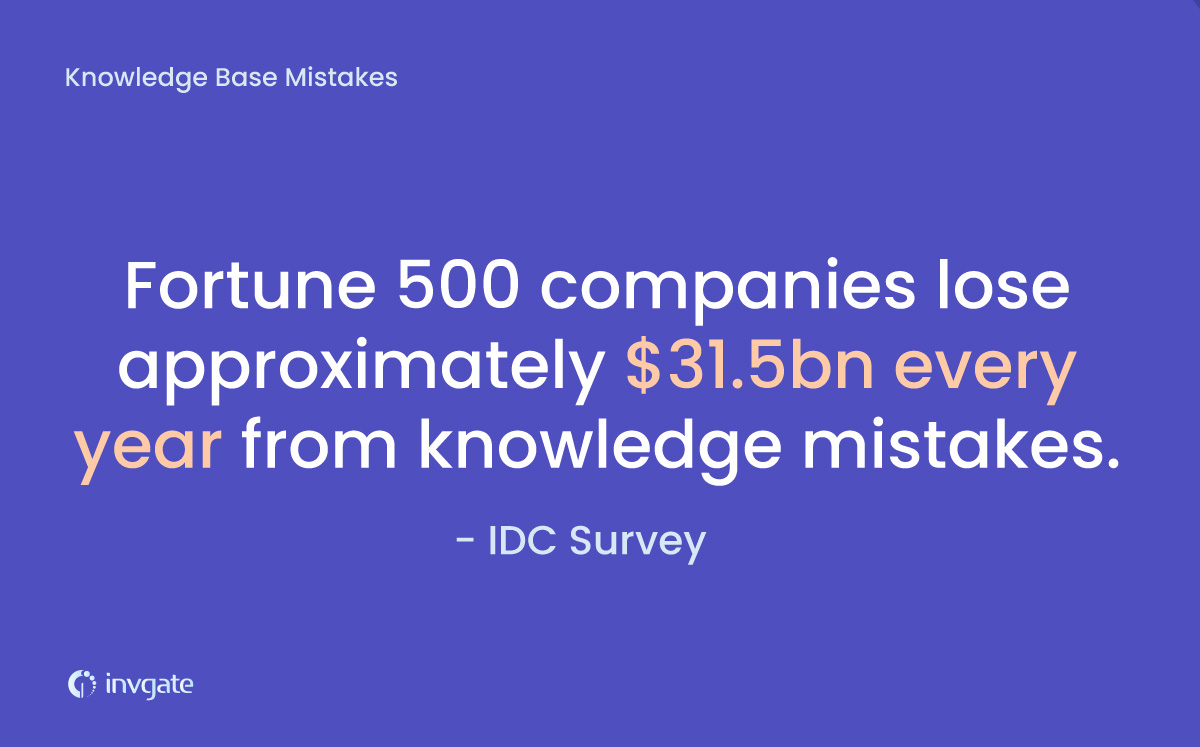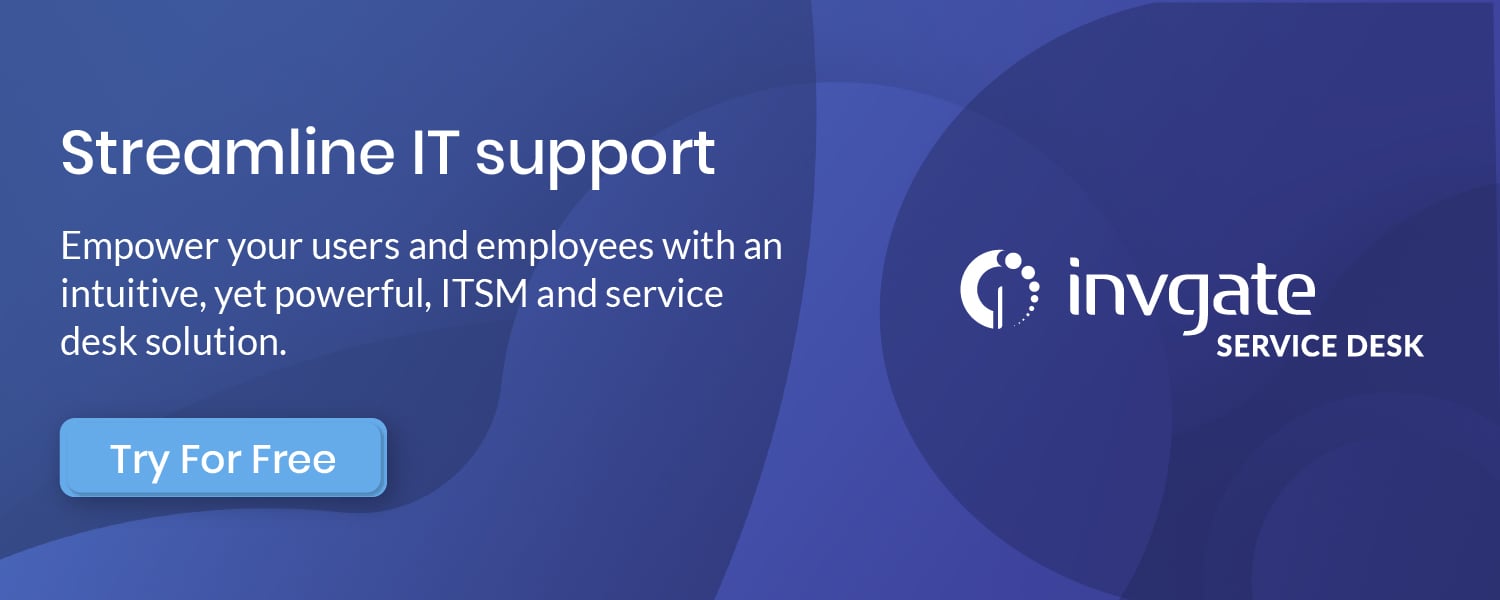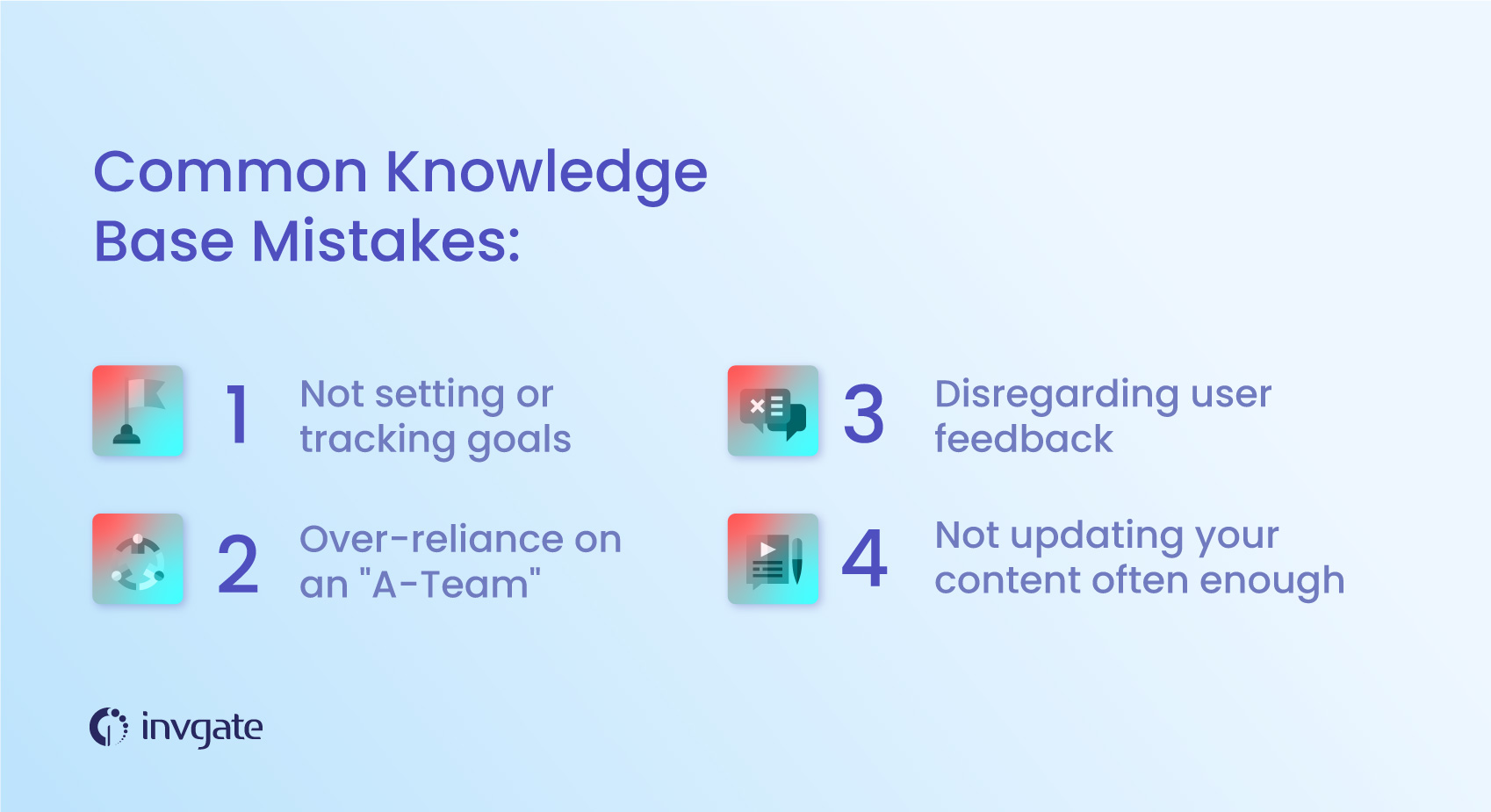We’ve been pretty enthusiastic about teaching you how to create a solid knowledge base. Yet knowledge base mistakes are still very common despite our best attempts to crush them into oblivion. This article is here to help you avoid those pesky sandtraps.
According to an IDC survey, Fortune 500 companies lose a staggering $31.5bn yearly from knowledge base mistakes alone. Or, in other words, companies lose money from their inability to effectively share knowledge. And the reason why is because they’re attempting to find that scattered information where it should be near-instantaneous to access.

As we said in our previous knowledge base best practices piece:
“Every organization requires a knowledge management strategy to handle this ever-growing mass of information and knowledge. This includes maintaining the consistency of the knowledge across the network and updating it as it changes.”
And of course, this can lead to mistakes in customer support as well. If employees are not able to quickly solve queries because they can’t access the proper knowledge, customer satisfaction can go downhill fast.
So, let’s not let this be you.
Common Knowledge Base Mistakes To Avoid
1. Not tracking and setting goals
One of the most common knowledge base mistakes is not even knowing where all of your efforts are leading. And this happens by not improving and continuously refining your knowledge base — something that’s only possible if you reliably set concrete goals and track your progress in reaching them.
This is where analytics and dashboards come in. They let you have an overarching view of article authorship, views, and other important metrics. With these things in hand, you’ll be able to assess the overall health of your internal knowledge base, and whether any changes have to be made before user engagement drops altogether.
You want to keep an eye on your dashboard to make sure your knowledge base content is on point. As a result, you’ll be able to expand on articles that need to, patch up possible weak points, and keep the momentum going in the right direction.
2. Over-reliance on an A-Team
Leaning hard on your A-team can also have the effect of overburdening your best and brightest, and that’s something you definitely don’t want.
At its best, your knowledge bases should keep everybody on the same page. That means all teams, departments, and individuals should be collaborating and doing their part to maintain the system; sharing the load, so to speak, will also gradually help improve and widen the scope of your content. Even if your best are taking care of things, everybody’s susceptible to tunnel vision.
But, your company is probably comprised of experts in their respective fields. If everybody contributes to the subject matter they know most about, that helps the overall game plan. If you create the correct editorial structure, you’ll also get over the hurdle of anyone in the organization being able to contribute content. This, in turn, helps sidesteps department-specific jargon, or in-group thinking as well.
3. Disregarding user feedback
When it comes to knowledge management success, listening is paramount. But one of the most common knowledge base mistakes is companies putting their heads in the sand and pretending everything’s A-OK.
Therefore, attempt to gather comments and learn about what works and doesn’t in your processes. Make targeted changes aimed at improving things. And sometimes, the easiest way to do that is to assign the role of “knowledge management specialist” to the right person. Then, everyone in your organization — whether it’s a big company or a small business — should know who to turn to in their hour of need.
Moreover, you should be using your knowledge base to gather product user feedback. Things like surveys and comments can help you spot where you need to improve or help you overcome sticking points.
And, since your knowledge base is ever-evolving, this process doesn’t ever really end. Continual improvement, tinkering, and refinement is built into the system. Listening to user feedback is part of what keeps the engine going.
4. Not updating your content often enough
Opening an article hoping to find a solution and seeing that the content is out-of-date or mostly irrelevant is a situation no one wants to be put into. Thus, as a preventive measure, you should have easy ways to tag “stale” articles to easily and quickly bring them up to the required level.
You should also be proactively asking department heads and experts about possible updates. Bring them up to speed on the current state of articles and ask “Is this good enough?” and “Do we need to add any more content that expands on this?”
And, this can be compounded when you have an online knowledge base. And we say this because your IT support team is generally tasked with handling any updates to the website’s code and content.
Of course, even if they’re doing everything right, your IT suppor team is typically swimming in an ocean of unresolved tickets. And even in businesses that are otherwise healthy, confidence that IT can keep up with application development requests alongside their day-to-day tasks is… typically not very high. 
So, you want to make updating your knowledge base content easier. And this usually entails having some form of knowledge base software to help you out. This knowledge base software should make it easier to post new articles and update existing ones, and acting as a mediator so you don’t have to hassle your IT team on the regular.
InvGate Service Management empowers service desk agents to create articles from their day-to-day support work and tickets, and helps maintain the quality and usefulness of articles by receiving feedback from end users, analyzing them together with view counts and more usage statistics.
The idea is for users to utilize the knowledge base software for edits and changes without having to go through the backend, which they have no authorization to use. It’s the best way to cut out the middleman and let everyone do their thing.

Knowledge Base tips & tricks
Sometimes, you can get yourself out of a sticky situation by avoiding knowledge base mistakes. But, sometimes, the solution can be worse than the problem. Meaning, despite your best attempts, these issues can create other issues that are even more glaring.
Keep it user friendly.
You have a knowledge base set up, good on you! But, if it’s not user friendly, then we guarantee that people are not going to be coming back to it often.
Moreover, if you don’t have a larger framework already set up, it’s very easy for the whole structure to become unwieldy and chaotic as it grows. And grow it will, because, as we’ve already established, the pace of change is constant and waits for no one.
Make sure to organize your knowledge base content into categories that make sense and go beyond mere cutely titled “How To” articles. Otherwise, you’ll have a big library that no one’s going to want to visit. On top of that, making sense of all that content post-hoc is not going to be an easy task.
Use a style guide.
Ideally, you should know what type of tone and language you want your authors to be writing your content with. Otherwise, you’ll just have a tonally mixed bag where things can jump between styles like a Quentin Tarantino movie.
Emily Kinzing, from Nerdwallet, framed it thus:
“Taking time to decide what you want your tone and approach to things like bullets, phrasing, etc. to be early on can help with ensuring a consistency of voice across articles that may be written by different people.”
Be proactive and craft a style guide. And then, make sure your editors or knowledge base content manager enforces it.
Treat your knowledge base like a product.
Would you let an inconsistent, error-filled product reach your customers? Of course not. Similarly, you wouldn't want to let a knowledge base be anything other than the best it can be when so much of your business success is riding on it.
And, whether or not your knowledge base is strictly internal or customer-facing, that means that documentation is not some afterthought, but a priority. Everyone should be finding the information they’re looking for easily, but that information should also be:
- Clear
- Readable
- Accessible
- And have plenty of care, thought, and attention lavished onto it.
It’s definitely no understatement to say that you should have adequate resources piled on your knowledge base content to make it the best it can be at all times.
Final thoughts
Knowledge base mistakes are hard to avoid. Still, that means that you should be ever-vigilant and striving for constant progress. Otherwise, you can shoot yourself in the foot and set yourself back a ways in your efforts.
Both employees and customers — all users — should be having the best possible user experience with your knowledge base. This means that constant updates, edits, monitoring, rewrites, sticking to style guides, and revisions are pretty much par for the course. As time-consuming and resource-intensive as it is, it’s a necessary part of business.














.jpg?upsize=true&upscale=true&width=780&height=205&name=ITIL%20Foundation%20Exam%20(2).jpg)
